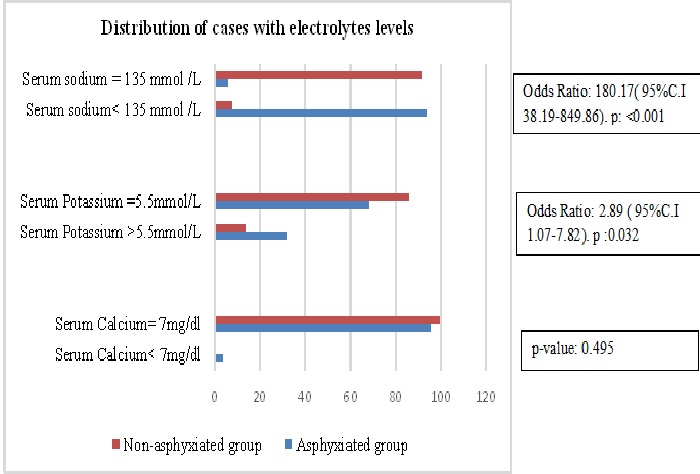A comparative study of serum electrolytes in newborns with birth asphyxia and non-asphyxiated newborns
Abstract
Background: Birth asphyxia is a common neonatal problem and contributes significantly to neonatal morbidity and mortality. HIE is the foremost concern in asphyxiated neonate because contrary to other system derangements this has the potential to cause serious long term neuromotor sequel among survivors.Sodium, potassium and calcium are the major electrolytes in human body, and any deviation from their normal levels in blood might cause convulsions, shock and other metabolic abnormalities. Immediate aggressive treatment of these abnormalities could modify the entire outcome of the babies.
Methods: The study was a case control study conducted over a period of 2years. Case (asphyxiated) group comprised of term babies weighing 2.5 kg or more with birth asphyxia. Birth asphyxia was said to be present in those babies who had a definite APGAR score of less than 7 at 1 minute of birth. Control (non-asphyxiated) group was made up of term babies weighing 2.5 kg or more with APGAR scores of 7 or more at 1 minute of birth. Blood samples collected were immediately sent to the biochemistry lab for evaluation of serum sodium, potassium and calcium.
Results: A total of 100 newborn babies were included in the study, 50 babies in case group and 50 babies in control group. Mean serum sodium and calcium values were significantly lower in the asphyxiated group when compared to the non-asphyxiated group. Mean serum potassium was significantly higher in the asphyxiated group when compared to the non-asphyxiated group. The mean serum sodium and calcium values in severely asphyxiated babies were significantly lower when compared to mild/moderately asphyxiated babies and the non-asphyxiated group.
Conclusions: As serum sodium levels are low in birth asphyxia, fluids must be managed judiciously in asphyxiated newborns.
Downloads
References
2. Perlman JM , Tack ED, Martin T, et al. Acute systemic organ injury in term infants after asphyxia. Am J Dis Child. 1989 May;143(5):617-20.[pubmed]
3. Perlman JM. Markers of asphyxia and neonatal brain injury. N Engl J Med. 1999 Jul 29;341(5):364-5. doi:10.1056/NEJM199907293410510.[pubmed]
4. Volpe JJ. Neurology of newborn, 3rd ed, W. B. Saunders Company, 1995:211-360.
5. Marlow N. Do we need an Apgar score? Arch Dis Child. 1992 Jul;67(7 Spec No):765-7.[pubmed]
6. Porter KB , O'Brien WF, Benoit R. Comparison of cord purine metabolites to maternal and neonatal variables of hypoxia. Obstet Gynecol. 1992 Mar;79(3):394-7.[pubmed]
7. Palmer C ,Vannucci RC, Towfighi J. Reduction of perinatal hypoxic-ischemic brain damage with allopurinol. Pediatr Res. 1990 Apr;27(4 Pt 1):332-6. doi:10.1203/00006450-199004000-00003.
8. Poulsen JP ,Rognum TO, Oyasaeter S, Saugstad OD. Changes in oxypurine concentrations in vitreous humor of pigs during hypoxemia and post-mortem. Pediatr Res. 1990 Nov;28(5):482-4. doi:10.1203/00006450-199011000-00013.
9. Swanström S, Bratteby LE. Hypoxanthine as a test of perinatal hypoxia as compared to lactate, base deficit, and pH.Pediatr Res. 1982 Feb;16(2):156-60.[pubmed]
10. Poulsen JP, Oyasaeter S, Sanderud J, et al. Hypoxanthine, xanthine, and uric acid concentrations in the cerebrospinal fluid, plasma, and urine of hypoxemic pigs. Pediatr Res. 1990 Nov;28(5):477-81. doi:10.1203/00006450-199011000-00012.[pubmed]
11. Basu P, Som S, Das H, Choudhuri N. Electrolyte status in birth asphyxia. Indian J Pediatr. 2010 Mar;77(3):259-62. doi: 10.1007/s12098-010-0034-0. Epub 2010 Feb 22.[pubmed]
12. Onyiriuka A N. Prevalence Of Neonatal Hypocalcaemia Among Full-Term Infants With Severe Birth Asphyxia.PJMS; 2011 April; 8(1): 3-12.
13. Jajoo D, Kumar A, Shankar R, Bhargava V. Effect of birth asphyxia on serum calcium levels in neonates. Indian J Pediatr. 1995 Jul-Aug;62(4):455-9.[pubmed]

Copyright (c) 2018 Author (s). Published by Siddharth Health Research and Social Welfare Society

This work is licensed under a Creative Commons Attribution 4.0 International License.


 OAI - Open Archives Initiative
OAI - Open Archives Initiative


